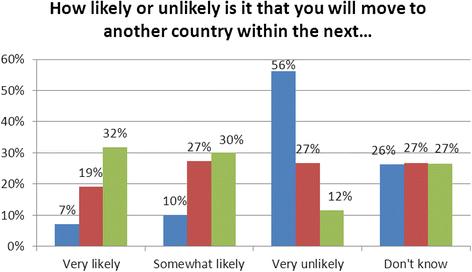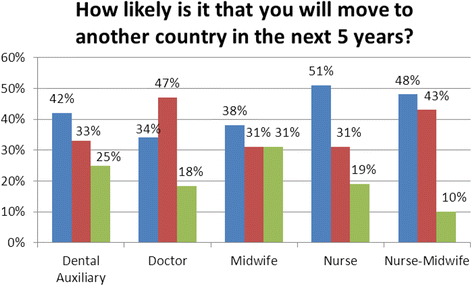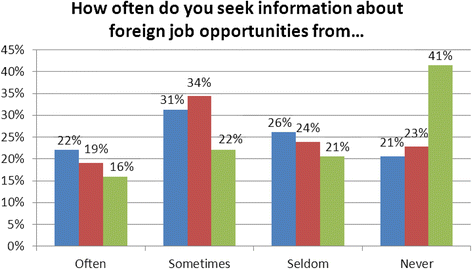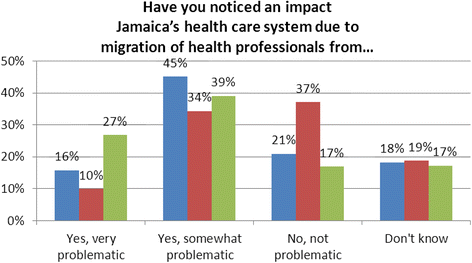A mixed-methods study of health worker migration from Jamaica
- PMID: 27380830
- PMCID: PMC4943490
- DOI: 10.1186/s12960-016-0125-8
A mixed-methods study of health worker migration from Jamaica
Abstract
Background: This study sought to better understand the drivers of migration, its consequences, and the various strategies countries have employed to mitigate its negative impacts. The study was conducted in four countries-Jamaica, India, the Philippines, and South Africa-that have historically been 'sources' of health workers migrating to other countries. The aim of this paper is to present the findings from the Jamaica portion of the study.
Methods: Data were collected using surveys of Jamaica's generalist and specialist physicians, nurses, midwives, and dental auxiliaries, as well as structured interviews with key informants representing government ministries, professional associations, regional health authorities, healthcare facilities, and educational institutions. Quantitative data were analyzed using descriptive statistics and regression models. Qualitative data were analyzed thematically. Multiple stakeholder engagement workshops were held across Jamaica to share and validate the study findings and discuss implications for the country.
Results: Migration of health workers from Jamaica continues to be prevalent. Its causes are numerous, long-standing, and systemic, and are largely based around differences in living and working conditions between Jamaica and 'destination' countries. There is minimal formal tracking of health worker migration from Jamaica, making scientific analysis of its consequences difficult. Although there is evidence of numerous national and international efforts to manage and mitigate the negative impacts of migration, there is little evidence of the implementation or effectiveness of such efforts. Potential additional strategies for better managing the migration of Jamaica's health workers include the use of information systems to formally monitor migration, updating the national cadre system for employment of health personnel, ensuring existing personnel management policies, such as bonding, are both clearly understood and equitably enforced, and providing greater formal and informal recognition of health personnel.
Conclusion: Although historically common, migration of Jamaica's health workers is poorly monitored and understood. Improved management of the migration of Jamaica's health workers requires collaboration from stakeholders across multiple sectors. Indeed, participating stakeholders identified a wide range of potential strategies to better manage migration of Jamaica's health workers, the implementation and testing of which will have potential benefits to Jamaica as well as other 'source' countries.
Keywords: Dental auxiliaries; Doctors; Health workers; Human resources for health; Jamaica; Midwives; Migration; Nurses; Policy.
Figures




Similar articles
-
Causes, consequences, and policy responses to the migration of health workers: key findings from India.Hum Resour Health. 2017 Apr 5;15(1):28. doi: 10.1186/s12960-017-0199-y. Hum Resour Health. 2017. PMID: 28381289 Free PMC article.
-
Health worker migration from South Africa: causes, consequences and policy responses.Hum Resour Health. 2015 Dec 3;13:92. doi: 10.1186/s12960-015-0093-4. Hum Resour Health. 2015. PMID: 26635007 Free PMC article.
-
The "brain drain" of health care workers: causes, solutions and the example of Jamaica.Can J Public Health. 2012 Jul 18;103(5):e376-8. doi: 10.1007/BF03404445. Can J Public Health. 2012. PMID: 23617992 Free PMC article.
-
Migration motives and integration of international human resources of health in the United Kingdom: systematic review and meta-synthesis of qualitative studies using framework analysis.Hum Resour Health. 2018 Jun 27;16(1):27. doi: 10.1186/s12960-018-0293-9. Hum Resour Health. 2018. PMID: 29945616 Free PMC article.
-
Medical tourism's impacts on health worker migration in the Caribbean: five examples and their implications for global justice.Glob Health Action. 2015 Apr 10;8:27348. doi: 10.3402/gha.v8.27348. eCollection 2015. Glob Health Action. 2015. PMID: 25865122 Free PMC article. Review.
Cited by
-
Palliative care integration: a critical review of nurse migration effect in Jamaica.BMC Palliat Care. 2021 Oct 13;20(1):155. doi: 10.1186/s12904-021-00863-7. BMC Palliat Care. 2021. PMID: 34641826 Free PMC article. Review.
-
Caribbean nurse migration-a scoping review.Hum Resour Health. 2020 Mar 16;18(1):19. doi: 10.1186/s12960-020-00466-y. Hum Resour Health. 2020. PMID: 32178696 Free PMC article.
-
Addressing the move toward universal health in the Caribbean through strengthening the health workforce.Rev Panam Salud Publica. 2023 Mar 10;47:e6. doi: 10.26633/RPSP.2023.6. eCollection 2023. Rev Panam Salud Publica. 2023. PMID: 36909800 Free PMC article.
-
Country-Level Factors Associated With Nurse Salaries: Empirical Evidence From Organisation for Economic Co-operation and Development Countries and Taiwan.J Nurs Res. 2023 Dec 1;31(6):e303. doi: 10.1097/jnr.0000000000000585. J Nurs Res. 2023. PMID: 37988058 Free PMC article.
-
The Experiences of Ghanaian Midwives on the Use of Nonadjustable Delivery Beds: A Qualitative Study.SAGE Open Nurs. 2021 Sep 14;7:23779608211038204. doi: 10.1177/23779608211038204. eCollection 2021 Jan-Dec. SAGE Open Nurs. 2021. PMID: 34869857 Free PMC article.
References
-
- Statistical Institute of Jamaica . Population and household census, 2011. Kingston: STATIN; 2013.
-
- World Bank . Data: Jamaica. 2013.
-
- World Health Organization . WHO global health workforce statistics. Geneva: WHO; 2013.
-
- World Bank. Migration and remittances factbook 2011: Jamaica. http://siteresources.worldbank.org/INTPROSPECTS/Resources/334934-1199807.... Accessed 14 April 2014.
-
- Gordon A. Medical institute opens doors in St. Elizabeth. The Gleaner, March 30, 2011. http://jamaica-gleaner.com/gleaner/20110330/news/news5.html. Accessed 8 April 2014.
Publication types
MeSH terms
Grants and funding
LinkOut - more resources
Full Text Sources
Other Literature Sources
Medical

